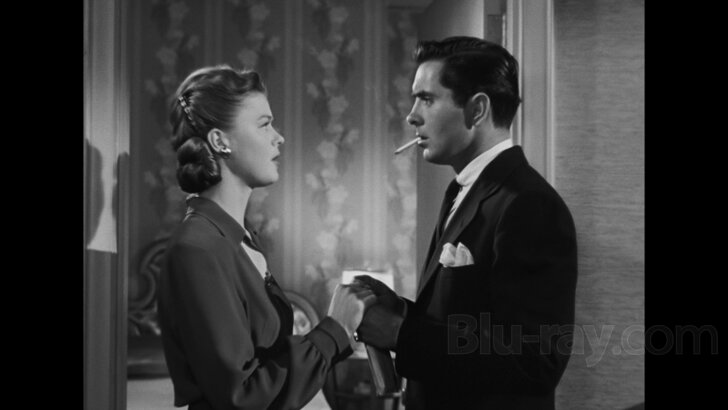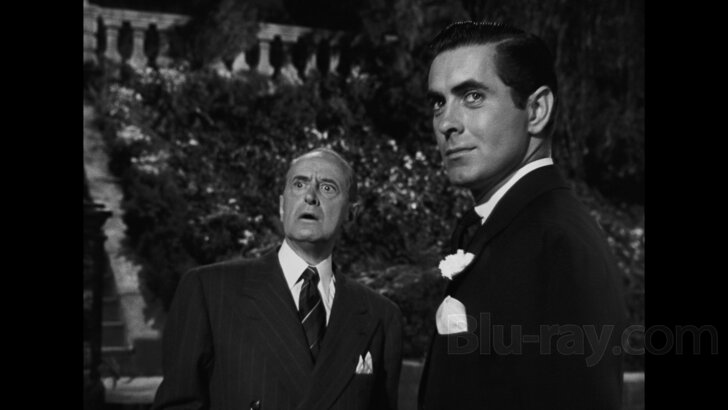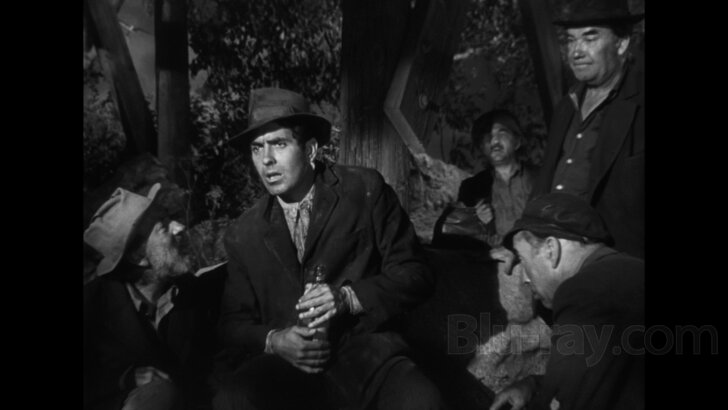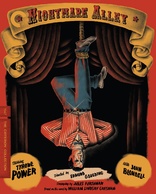Nightmare Alley Blu-ray Movie
HomeNightmare Alley Blu-ray Movie 
Criterion | 1947 | 112 min | Not rated | May 25, 2021Movie rating
7.8 | / 10 |
Blu-ray rating
| Users | 4.8 | |
| Reviewer | 4.5 | |
| Overall | 4.5 |
Overview
Nightmare Alley (1947)
Stanton Carlisle is a lowlife working in a carnival. Knowing a good con when he sees one, he learns the tricks of a mind-reading act from Zeena, then tosses her aside. In time, he becomes "The Great Stanton," star attraction of swanky nightclubs and the darling of society. But with all his notoriety built on lies, it's only a matter of time before exposure brings Stanton's world crashing down around him.
Starring: Tyrone Power, Joan Blondell, Coleen Gray, Helen Walker, Taylor Holmes (I)Director: Edmund Goulding
| Film-Noir | 100% |
| Drama | 98% |
Specifications
Video
Video codec: MPEG-4 AVC
Video resolution: 1080p
Aspect ratio: 1.37:1
Original aspect ratio: 1.37:1
Audio
English: LPCM Mono (48kHz, 24-bit)
Subtitles
English SDH
Discs
Blu-ray Disc
Single disc (1 BD)
Playback
Region A (locked)
Review
Rating summary
| Movie | 5.0 | |
| Video | 4.5 | |
| Audio | 5.0 | |
| Extras | 3.5 | |
| Overall | 4.5 |
Nightmare Alley Blu-ray Movie Review
Reviewed by Dr. Svet Atanasov May 15, 2021Edmund Goulding's "Nightmare Alley" (1947) arrives on Blu-ray courtesy of Criterion. The supplemental features on the disc include archival interview with actress actress Coleen Gray; new program with performer and sideshow historian Todd Robbins; new interview with critic Imogen Sara Smith; and more. In English, with optional English SDH subtitles for the main feature. Region-A "locked".

They don't stand a chance now.
The world is a much easier place to navigate once you realize that it is populated by two kinds of people: players and those that allow to be played. The many wars and different political ideologies that have tried to refute this timeless truth have only provided ample evidence that the status quo will be permanent because the division is preprogrammed by human nature. Indeed, the players are simply naturally smarter and better at selling lies that the played find relevant. There are other variations of the truth where the players are essentially identified as predators, but they are inferior because they imply that the players are driven by animalistic instincts rather than superior intellect. To be a player, one has to be able to see clearly the bigger picture and then invent ways to exploit it, which cannot be accomplished while relying on animalistic instincts.
Edmund Goulding’s film Nightmare Alley is about a man who realizes that he has what it takes to be a player and gets a chance to prove that he belongs amongst the best of them. His name is Stan Carlisle (Tyrone Power) and his transformation begins after he joins a traveling carnival and becomes an assistant to a veteran mind-reader (Joan Blondell) struggling to take care of her alcoholic husband (Ian Keith). At the right time, Carlisle permanently separates the two, and after he gains recognition through his work leaves the carnival behind and begins a new solo act as a gifted mentalist. In Chicago, Carlisle then befriends a well-connected psychologist (Helen Walker) who helps him wow some of the city’s most prominent figures, and shortly after together they develop a scheme to siphon off large sums of money from their bank accounts. However, in the midst of his remarkable progress, Carlisle sees his philosophy of life questioned by a former lover who has become his most trusted assistant (Coleen Gray).
The main reason Nightmare Alley remains a timeless film is the striking clarity with which it reveals the truth that is described at the top of this article. In the past, some critics have argued that the clarity is actually a rather disturbing form of cinematic cynicism, but such a description is nothing more than an overreaction fueled by flawed or/and dated understandings of what ought to be morally right and wrong. Here are a few examples proving that it is so:
Because Carlisle is immune to moral refutation, at the right time he is able to exploit the vulnerabilities of the veteran mind-reader and move on to the next level. Also, at the core of Carlisle’s relationship with the psychologist is the crucial understanding that one cannot be a player if one allows the played to define the rules of the game that is responsible for one’s progress. So, by contemporary standards Carlisle is essentially an exemplary pragmatic with crystal-clear priorities that have shaped up his exceptional ability to manipulate his targets.
All of the troubles that Carlisle faces in the final third of the film are a byproduct of his decision to consider viewing the world as the played do. It is an unforgivable mistake because he instantly loses his superiority and, in the process, allows to become a target for other ‘amoral’ players that have viewed him as a dangerous competitor. This is why towards the end the film justifiably suggests that the best players that reach the top and wish to remain there ought to be prepared to pay the price of enjoying their success alone -- loneliness is their most reliable insulation against the corrosive effects of morality.
Predictably, the film’s very dark pragmatism proved quite problematic and its box office performance did not meet the expectations of the studio that funded it. However, since the 1940s it has been consistently, and rightfully, ranked amongst the greatest masterpieces of the film noir genre.
*Nightmare Alley is based on William Lindsay Gresham's 1946 novel of the same name. While Jules Furthman's screenplay captures the tone and mood of the original material very well, the novel has a different, much grimmer finale.
Nightmare Alley Blu-ray Movie, Video Quality 

Presented in its original aspect ratio of 1.37:1, encoded with MPEG-4 AVC and granted a 1080p transfer, Nightmare Alley arrives on Blu-ray courtesy of Criterion.
The following text appears inside the leaflet that is provided with this Blu-ray release:
"This new digital transfer was created in 4K resolution at Cineric in New York, on the facility's proprietary 4K high-dynamic-range wet-gate film scanner, from a 35mm nitrate composite print from the Disney/Fox Collection at the UCLA Film & Television Archive. The origin al monaural soundtrack was remastered from a 35mm nitrate composite print with a variable-density track from the Disney/Fox Collection at the UCLA Film & Television Archive.
4K restoration: Cineric/New York.
Audio restoration: Audio Mechanics/Burbank, CA.
Audio transfer of variable-density track: Endpoint, Audio Labs/Burbank".
The film looks very healthy and, contrary to early reports, has a solid overall organic appearance. However, because the new 4K master wasn't struck from a first-generation element (OCN), there are a few source limitations that occasionally impact areas like density, delineation, and grayscale balance. For example, even though grain is visible throughout the entire film, in some areas it can appear slightly underexposed/subdued. This effect can be further exacerbated by unique lighting conditions and specific stylistic choices, with the most obvious examples emerging in darker areas where different ranges of shadows can become quite prominent. But even in very, very dark areas there is still plenty of natural grain. Screencapture # 10 is from one such very dark area. Screencaptures #1, 2, 5, 20, 24 should give you a pretty good idea how well grain is exposed elsewhere in the film. (To get an idea what a remastered/restored and then thoroughly degrained film from the same era looks like, see Twentieth Century Fox's presentation of Panic in the Streets). Furthermore, while grain can appear underexposed, some highlights can appear very slightly overexposed. You can see examples in screencaptures #15, 17, and 21. However, the grayscale is still very nicely balanced and there are no distracting anomalies to report in our review. Image stability is excellent. Some noise management work has been performed, but this is a standard procedure and the work here is very effective. The entire film looks spotless. So, while ideally this film could look better, the current restoration has strong organic qualities and is very pleasing. (Note: This is a Region-A "locked" Blu-ray release. Therefore, you must have a native Region-A or Region-Free player in order to access its content).
Nightmare Alley Blu-ray Movie, Audio Quality 

There is only one standard audio track on this Blu-ray release: English LPCM 1.0. Optional English SDH subtitles are provided for the main feature.
It is immediately obviously that the audio has been fully restored. It is clear and very stable, with a good range of nuanced dynamics as well. In the upper register, where older film usually reveal signs of weakness and aging, there are no distracting anomalies either.
Nightmare Alley Blu-ray Movie, Special Features and Extras 

- Trailer - a vintage trailer for Nightmare Alley. In English, not subtitled. (3 min, 1080p).
- Todd Robbins - in this new program, performer and sideshow historian Todd Robbins explains how actual carnival shows were staged, and specifically the 'freak shows', and the business environment that existed in carnival troupes. Nightmare Alley and its portrayal of the carnival businesses is addressed as well. The program was produced for Criterion in 2021. In English, not subtitled. (20 min, 1080p).
- Coleen Gray - in this archival interview, actress Coleen Gray recalls her involvement with Nightmare Alley. There are some particularly interesting comments about the manner in which Tyrone Power was cast by Twentieth Century Fox and his 'classic' image as a 'pretty boy' in Hollywood. The interview was recorded by filmmaker Patrick Francis in 2007. In English, not subtitled. (13 min, 1080p).
- Henry King - presented here is an excerpt from an archival audio interview with director Henry King that was conducted by Thomas R. Stemple in January 1971 and recorded as part of the Darryl F. Zanuck Research Project for the American Film Institute's Oral History Collection. In it, the director discusses his work with Tyrone Power, who appeared in eleven of his films. In English, not subtitled. (10 min, 1080p).
- Imogen Sara Smith - in this new video interview, critic Imogen Sara Smith, author of Lonely Places: Film Noir Beyond the City, discusses Nightmare Alley. The interview was conducted for Criterion in New York in January 2021. In English, not subtitled. (32 min, 1080p).
- Commentary - this archival audio commentary was recorded by film historians James Ursini and Alain Silver in 2005. It was included on Twentieth Century Fox's 2005 DVD release.
- Leaflet - an illustrated leaflet featuring screenwriter Kim Morgan's essay "The Fool Who Walks In Motley..." as well as technical credits.
- Tarot Cards - six tarot cards. (See screencaptures).
Nightmare Alley Blu-ray Movie, Overall Score and Recommendation 

It is strange that Nightmare Alley exists because once you discard its noir identity it very quickly becomes the type of eye-opener Hollywood has always been uncomfortable tolerating. Indeed, the film's dissection of the game of life is so simple yet accurate that it is actually genuinely disturbing, and this type of social sincerity is never good for business. It can force anyone to discover lies that have had a profound impact on personal relationships, career choices, business relationships, and all the other things that supposedly make our lives meaningful, and once seen, they can no longer be unseen. This is the main reason Nightmare Alley is a timeless classic -- its message is completely immune to intelligent refutation. Criterion's upcoming release is sourced from a new and very good 4K master. VERY HIGHLY RECOMMENDED.
Similar titles
Similar titles you might also like

Ace in the Hole
1951

Night and the City
1950

The Lost Weekend
1945

Scarface
1932

The Naked City
1948

On Dangerous Ground
Warner Archive Collection
1951

The Dark Mirror
1946

A Face in the Crowd
1957

Double Indemnity 4K
1944

Stray Dogs
郊游 / Jiao you
2013

The Crooked Web
1955

Leave Her to Heaven
1945

Scarlet Street 4K
1945

Force of Evil
4K Restoration
1948

Out of the Past
Warner Archive Collection
1947

Two Men in Manhattan
Deux hommes dans Manhattan
1959

Flamingo Road
Warner Archive Collection
1949

Where the Sidewalk Ends
Limited Edition to 3000 - SOLD OUT
1950

High Sierra
1941

Phantom Lady
1944
